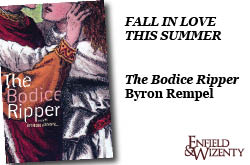Many of my own novels are set in the midst of war. It’s not that I love war, but I do like to see how an ordinary person steps up in extraordinary times.
 Christine Kohler’s No Surrender Soldier (Merit Press) is a war novel, but it deals with the aftermath: that long after a war ends, the effects live on. There are so many things that I love about No Surrender Soldier, not the least of which is that it delves into a geography and time that I knew nothing about. I also love that she shows on so many levels and with so many different characters how the effects of war can last for generations after the final truce has been signed.
Christine Kohler’s No Surrender Soldier (Merit Press) is a war novel, but it deals with the aftermath: that long after a war ends, the effects live on. There are so many things that I love about No Surrender Soldier, not the least of which is that it delves into a geography and time that I knew nothing about. I also love that she shows on so many levels and with so many different characters how the effects of war can last for generations after the final truce has been signed.
Christine kindly agreed to answer some questions about her book.
No Surrender Soldier is set in Guam in the 1970s and you delve into Chamorro and Japanese culture and traditions, but you’re from Ohio and it is 2014. Tell me about your research challenges and aha moments.
During the 1980s I worked and lived on Pacific islands. I graduated from the University of Hawaii with a journalism degree, and I worked as a political reporter and foreign correspondent for Gannett, covering the West Pacific. I also lived in Japan and on Guam. When I travelled throughout Asia Pacific I had no idea that I would someday be writing a novel. However, my dad instilled in me a love of history so I visited many World War II battle sites. I also brought back to the mainland a Guam history book. All of these marvelous experiences I would later pour into writing No Surrender Soldier.
This novel is written in intertwining points of view: from Seto’s, a Japanese soldier who didn’t surrender when the war ended, and Kiko’s, a young native of Guam. Which of these two story threads came easiest to you? Why?
Isamu Seto’s voice and character came first and easiest. The reason the World War II Japanese soldier’s story was easiest to tell is because Seto is based on the real “no surrender soldier” Shoichi Yokoi, who hid in the jungle for twenty-eight years after Guam was liberated. That’s what I love about research, it informs the plot and character. As for Seto’s voice, from the very beginning I knew I wanted it poetic and spare. I wanted his voice to sound haunting. This is a deeply wounded soul who is also fearful, lonely, and suffering deprivation. So with Seto’s voice I was not necessarily trying to imitate a Japanese voice, like I did giving Kiko a pidgin English dialect, as I was trying to capture a tone and mood in Seto’s voice.
Did the concept for the novel change as you wrote it?
The concept for the novel never changed from the first draft. There were only two things that changed from earlier drafts: the addition of a prologue and the framing beginning the first chapter.
Did you get any flack from your editors for including relatively graphic things like the pig slaughtering scene? What about reviewers? Kids?
My editor never said anything about the pig slaughter scene. Her initial objection was that the novel is too religious, but that’s a different story. However, before I submitted this novel I had it critiqued by two bright teen boys. My nephew, Ben, did object to the pig slaughter scene. I respect my nephew’s opinion, but I did not tone that chapter down because I needed it to be a key plot point involving sacrifice and rite of passage into manhood. I feel strongly that those are two elements missing for young men in our society today. I also modeled that chapter after William Golding’s Lord of the Flies. Yes, some reviewers have mentioned that they thought the slaughter chapter is graphic. But it is my opinion these reviewers must not have grown up on farms.
Your depiction of Seto’s underground living space was vividly gross and very real. How did you research that?
Seto’s underground hovel is exactly the way it is described and shown in photos of Yokoi’s underground tunnel in Talofofo. When I give research programs about No Surrender Soldier I show pictures of this tunnel.
Tatan, Kiko’s grandfather, has dementia. I love that you were able to show him in a nuanced way. Tell me about that.
When I was in graduate school in San Antonio I worked as a media specialist at Morningside Ministries, which specializes in Alzheimer’s care. Tatan is a composite of many people with dementia.
What’s been the response of readers? Reviewers?
No Surrender Soldier has gotten excellent reviews from Kirkus, Booklist, and the Asian Review of Books in Hong Kong.
Which character was the most challenging to write? Why?
Kiko’s voice was the most difficult to write. At first I had trouble with him sounding too whiny. I felt Kiko was resentful of circumstances in his life that he couldn’t control, such as having to care for his grandfather. I don’t think it’s unreasonable for a teen boy, or anyone for that matter, to feel resentment. Kiko also felt like he couldn’t talk to his mother for fear he would upset her. So he had to hold a lot of this resentment inside while at the same time he was confused and frustrated. So I struggled most with the beginning, the very first scene in the tourist shop. I was afraid I would lose readers before they gave Kiko a chance to tell his story.
Which character is most like you?
I don’t know if any of the characters are like me but if one is closest to how I feel at times it definitely has to be Kiko.
What is your writing routine?
When I’m thinking of a story I begin with research. I research until I am saturated and the main character walks onto the stage in my mind and begins to tell his or her story. Then I do what Jane Yolen calls “fly into the mist.” If it any time my well of research drains and the writing gets strained then I stop and research some more. About midway through I stop and completely outline the story from beginning to end, even if I don’t know the ending. I think I do this because I’m afraid of saggy middles. Often when I write a first draft I will plan my schedule even if it means going away and locking myself in a hotel room for a week; I will write the first draft in about six weeks. Then the hard work begins… revision!
What aspect of being a writer drives you nuts?
The times I can’t write because family schedules are too packed. I suppose the other part that drives me nuts is trying to land a publishing contract.
What are you working on now?
I am in the revision stage of a near–futuristic techno YA novel called Babel/Babble. It’s about a fifteen-year-old girl, Min Lee, who longs for intimacy for herself and for two whales that will go extinct if they don’t mate. It has awkward virtual sex, loss, romance, foreign travel, and music.
Aside from the usual “read a lot and write everyday” do you have advice for an aspiring author?
Study craft. Learn the business side of publishing. Join a critique group or do whole novel swaps. Don’t take criticism personally; learn from it. Attend writing workshops. Have a teachable spirit. And revise, revise, revise before submitting.






One Comment
Fascinating look behind the curtain! I’ve read No Surrender Soldier and love it for its many nuances and its lyrical prose as well as the powerful emotional journey of both main characters, and, of course, its theme of the need for forgiveness. But these glimpses into the actual creation of the novel tell another impressive and fascinating story all their own. Thanks for running this interview!